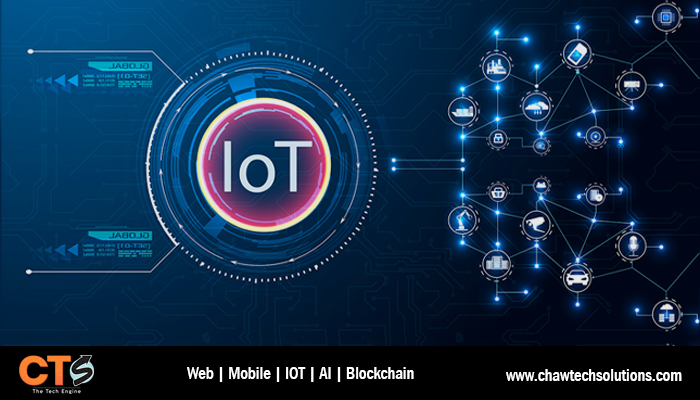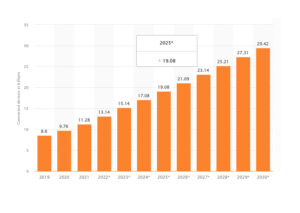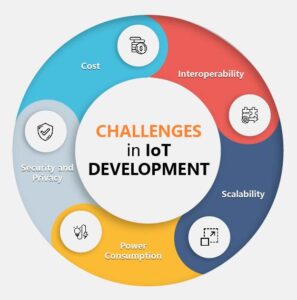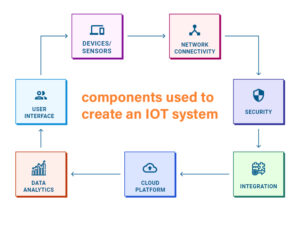
The Road to Building Successful IoT Systems: Navigating Development Challenges and Best Practices
Think about it, when you can control your home’s temperature, lights, and security system all from your phone. You can track your fitness progress with a smartwatch, or even monitor your pet’s activities while you’re away from home.
It all is happening in the near future with IoT (Internet of Things). IoT has so many benefits, it can help businesses be more efficient and reduce costs, improve healthcare by allowing for remote monitoring of patients, and even make cities smarter by optimizing traffic flow and reducing pollution.
IoT is all about making our lives more connected and convenient.
The Internet of Things has become an increasingly popular technology trend in recent years, with many businesses and consumers seeking to take advantage of the many benefits it offers. From smart homes and wearables to industrial sensors and automated factories, the IoT has the potential to transform the way we live and work.
A Statista report shares that there will be 19.08 billion devices connected with IoT in 2025.

However, developing successful IoT systems requires careful planning, collaboration, and attention to detail.
In this blog post, we will explore the process of IoT system development, the challenges involved, and best practices for overcoming them.
IoT System Development Process
IoT system development is a complex process that involves a wide range of technologies and skills. Here are the typical steps involved in developing an IoT system:
1. Idea and Conceptualization: The first step in IoT development is to define the idea or concept for the system. This may involve brainstorming sessions, market research, and stakeholder analysis to identify the potential applications and benefits of the system.
2. Hardware Design: The next step is to design the hardware components of the IoT system. This may involve selecting sensors, microcontrollers, communication protocols, and other hardware components based on the requirements of the system.
3. Software Development: Once the hardware components have been designed, the next step is to develop the software that will control the system. This may involve developing firmware for the hardware components, developing APIs for communication between components, and developing applications for end-users.
4. Connectivity: The IoT system must be able to connect to the internet and other devices to function properly. This may involve selecting the appropriate communication protocols, configuring networking hardware, and ensuring that the system can communicate with other devices and services.
5. Data Analytics: IoT systems generate large amounts of data that must be analyzed to extract insights and improve the system’s performance. This may involve developing data analytics algorithms, using machine learning techniques to analyze data, and implementing data visualization tools.
The vast amounts of data flowing into IoT devices can be effectively analyzed by AI, surpassing human capacity to detect underlying patterns. By incorporating machine learning, AI can further enhance its ability to anticipate necessary operational adjustments for optimized outcomes. AI development hence becomes another crucial process while building IoT.
6. Security and Privacy: IoT systems must be designed with security and privacy in mind to protect against unauthorized access and data breaches. This may involve implementing encryption, access control, and authentication mechanisms, and ensuring compliance with privacy regulations.
Challenges in IoT Development
Developing successful IoT systems can be challenging due to the complexity and interdependence of the various components involved. Here are some of the key challenges that developers may face:

1. Interoperability: IoT systems often involve a wide range of hardware and software components from different manufacturers. Ensuring that these components can work together seamlessly can be a major challenge, as different components may use different communication protocols, data formats, and APIs.
2. Scalability: IoT systems must be designed to handle large amounts of data and users, which can be a significant challenge. Ensuring that the system can scale up or down as needed without affecting performance or reliability requires careful planning and design.
3. Power Consumption: Many IoT systems rely on battery-powered devices that must operate for extended periods without recharging. Minimizing power consumption while maintaining performance and functionality is a significant challenge in IoT development.
4. Security and Privacy: As mentioned earlier, security and privacy are major concerns in IoT development. Ensuring that the system is secure and compliant with privacy regulations requires careful attention to detail and ongoing monitoring.
5. Cost: Developing IoT systems can be expensive, particularly for small and medium-sized businesses. Balancing the cost of development with the potential benefits of IoT systems can be a significant challenge.
Best Practices in IoT Development
Overcoming the challenges of IoT development requires careful planning and adherence to best practices. Here are some of the key best practices that developers should follow:
1. Standardization: Adopting standard communication protocols, data formats, and APIs can help ensure interoperability between different components of the IoT system.
2. Modularity: Developing modular hardware and software components can make it easier to upgrade or replace individual components without affecting the rest of the system. This can improve scalability, reduce downtime, and simplify maintenance.
3. Power Management: Minimizing power consumption is critical in IoT systems that rely on battery-powered devices. Using low-power components, optimizing software algorithms, and implementing sleep modes can help extend battery life and reduce power consumption.
4. Security and Privacy: Designing IoT systems with security and privacy in mind from the beginning is critical. This may involve implementing encryption, access control, and authentication mechanisms, and ensuring compliance with privacy regulations.
5. Testing and Validation: Thorough testing and validation are essential to ensure that the IoT system performs as expected and meets user requirements. This may involve conducting functional, performance, and security testing, as well as user acceptance testing.
6. Collaboration: Developing successful IoT systems often requires collaboration between hardware and software developers, data analysts, and other stakeholders. Ensuring open communication and collaboration throughout the development process can help ensure that everyone is working towards the same goals.
Components Used to Create an IoT System
An IoT (Internet of Things) typically consists of several components that work together to enable the collection, processing, and analysis of data from connected devices. Here are some of the key components that make up an IoT system:

1. Devices/sensors: These are the physical objects that are connected to the internet and generate data. They can be anything from a simple temperature sensor to a complex industrial machine.
2. Network connectivity: IoT devices communicate with each other and with cloud-based applications over the internet, so network connectivity is a critical component of any IoT application.
3. Cloud platform: This is where the data generated by IoT devices is stored and processed. A cloud platform can provide storage, computing power, and analytical tools for working with IoT data.
4. Data analytics: IoT data can be analyzed to identify patterns, detect anomalies, and gain insights that can be used to optimize operations, improve efficiency, and drive business value.
5. User interface: A user interface provides a way for users to interact with an IoT application. This can be a dashboard, a mobile app, or a web interface that displays data, provides alerts, and allows users to control IoT devices.
6. Security: IoT applications must be designed with security in mind to prevent unauthorized access, data breaches, and other cyber threats. This includes authentication, encryption, and other security measures to protect data and devices.
7. Integration: IoT applications often need to integrate with other systems and applications, such as ERP (Enterprise Resource Planning) systems, CRM (Customer Relationship Management) systems, and other business applications. Integration can be achieved through APIs (Application Programming Interfaces), webhooks, or other methods.
Cost Associated with IoT App Development:
IoT (Internet of Things) app development is a complex process that involves several stages and requires a team of skilled professionals to bring an idea to reality. One of the most critical factors that businesses and individuals must consider before developing an IoT app is the cost. We’ll now explore the factors that influence the cost of developing an IoT app.
1. App Complexity: The complexity of the app is a significant factor in determining the cost of IoT app development. Apps that require more features, functionalities, and integrations tend to be more expensive. For example, an app that collects data from hundreds of devices and displays it in real time requires more development time and expertise than a simple app that monitors a single device.
2. Development Team: The size and expertise of the development team also affect the cost of IoT app development. A larger team of experienced developers with specialized skills and knowledge in IoT app development will be more expensive than a smaller team of developers with less experience and expertise.
3. Platform: The platform on which the app will be developed can also affect the cost. Apps that are developed for multiple platforms, such as iOS, Android, and web-based platforms, tend to be more expensive than those developed for a single platform.
4. Security: Security is a critical aspect of IoT app development, and it can significantly impact the cost. A more secure app that has strong encryption and other security measures in place will require more development time and expertise, making it more expensive.
5. Infrastructure: The infrastructure required to support the app can also impact the cost. An app that requires a significant amount of cloud storage or data processing will be more expensive to develop than an app that requires less infrastructure.
6. Testing: Testing is a crucial stage in IoT app development that helps ensure the app is functional, reliable, and secure. Testing requires specialized tools and expertise and can add to the overall cost of app development.
The cost of IoT app development varies based on several factors, including the complexity of the app, the development team’s expertise, the platform, security, infrastructure, and testing.
Average IoT application development cost ranges between $10,000 and $50,000 which can vary according to specific business requirements.
Businesses and individuals must consider these factors before embarking on an IoT app development project to ensure that they have a clear understanding of the costs involved. By working with a team of experienced IoT app developers, businesses and individuals can ensure that their app is functional, secure, and meets their specific needs.
Tech Stack, You Need to Build A Successful IoT Application
Mobile app development is a crucial step in building IoT systems. The tech stack to build an IoT app depends on several factors such as the type of device or sensor used, the platform used to develop the application, and the infrastructure required to process and store data. The tech stack for building an IoT app requires a combination of hardware and software technologies.
However, here are some commonly used technologies and frameworks:
1. Programming languages: The choice of programming language depends on the device or sensor used in the IoT system. Some popular languages include C/C++, Python, Java, and JavaScript.
2. IoT platforms: There are several IoT platforms available, including AWS IoT, Azure IoT, and Google Cloud IoT. These platforms provide tools to manage and monitor devices, process data, and connect with other services.
3. Databases: IoT applications require data storage and retrieval, and databases such as MongoDB, Cassandra, and MySQL can be used to manage data.
4. Communication protocols: IoT devices use various communication protocols such as MQTT, CoAP, and HTTP. The choice of protocol depends on the device’s power consumption, data rate, and security requirements.
5. Cloud services: IoT applications require cloud services to process and store data. Some popular cloud services include AWS Lambda, Azure Functions, and Google Cloud Functions.
6. Data analytics tools: IoT data is often voluminous and requires analysis to gain insights. Tools such as Apache Spark and Hadoop can be used to analyze and process IoT data.
Wrapping Up:
It’s amazing how a few simple sensors and a little bit of connectivity can revolutionize the way we live, work, and interact with the world around us.
IoT development is a complex and challenging process that requires careful planning, collaboration, and attention to detail. By following best practices such as standardization, modularity, and collaboration, developers can overcome the challenges involved and build successful IoT systems. IoT offers exciting opportunities for innovation and growth. So, let’s embrace the power of IoT and see where it can take us!
If you’ve got any queries about building IoT applications or have an idea, do let us know by dropping an email at info@chawtechsolutions.com.
Connect with us on LinkedIn.







